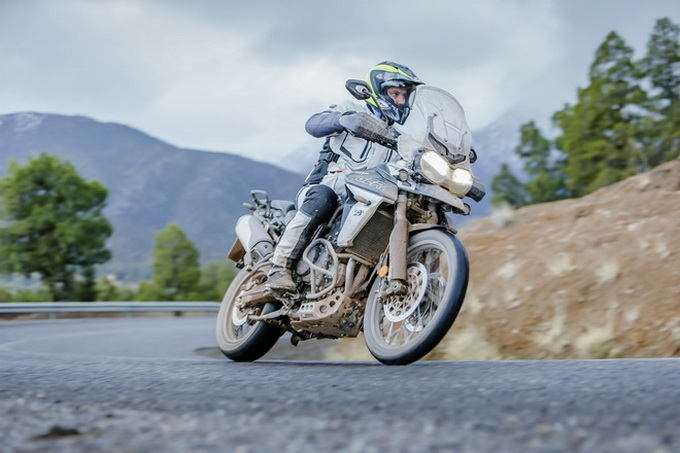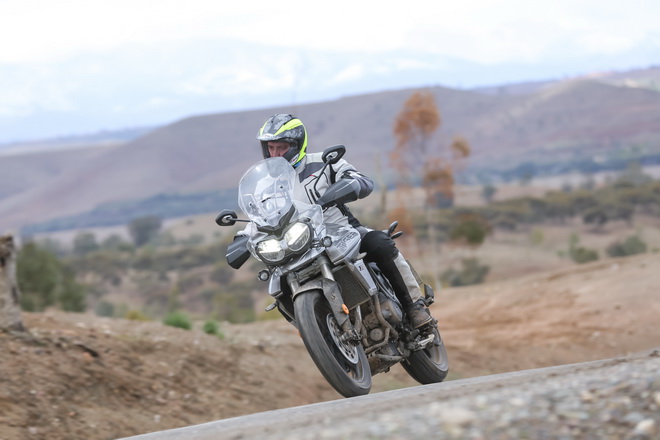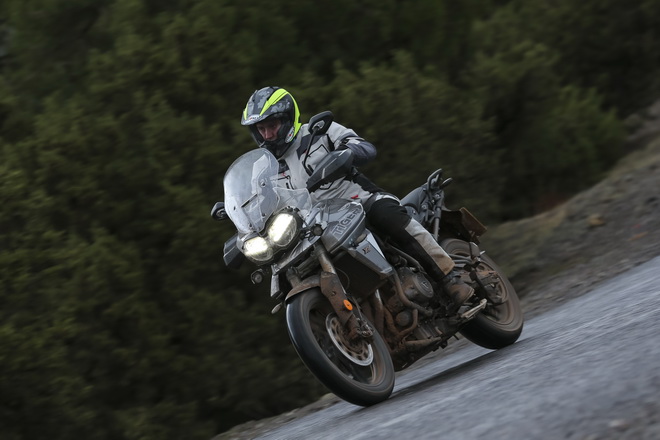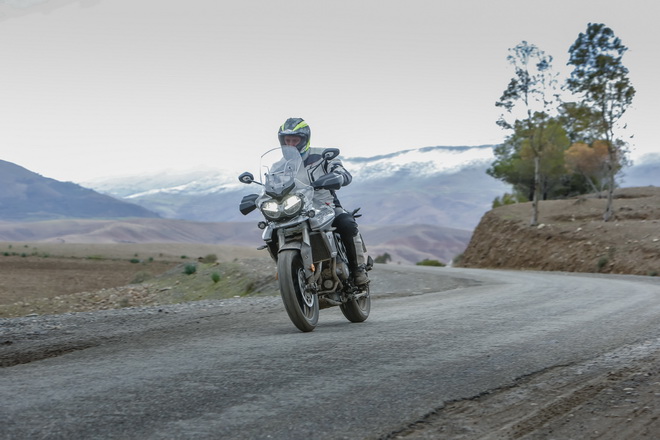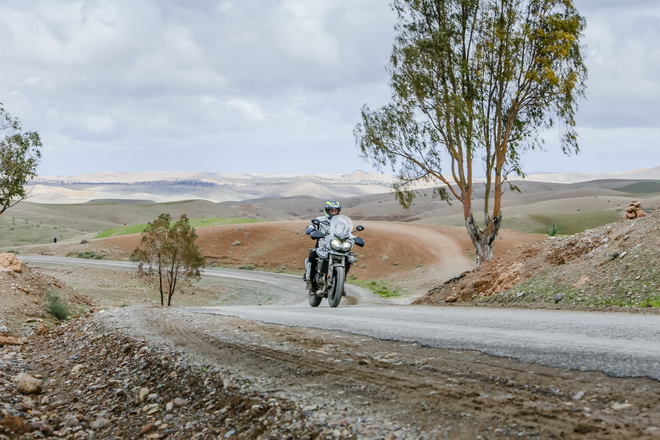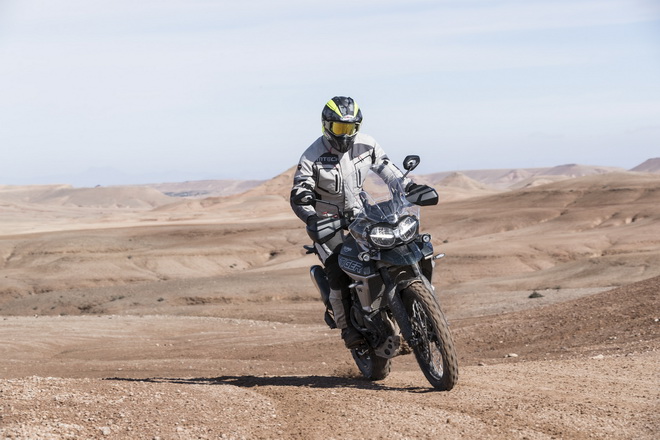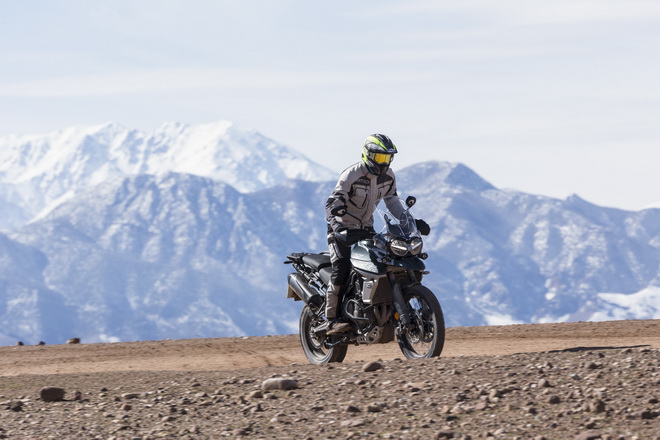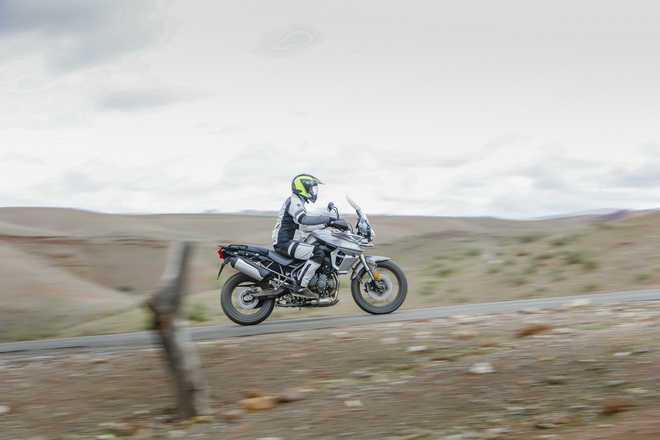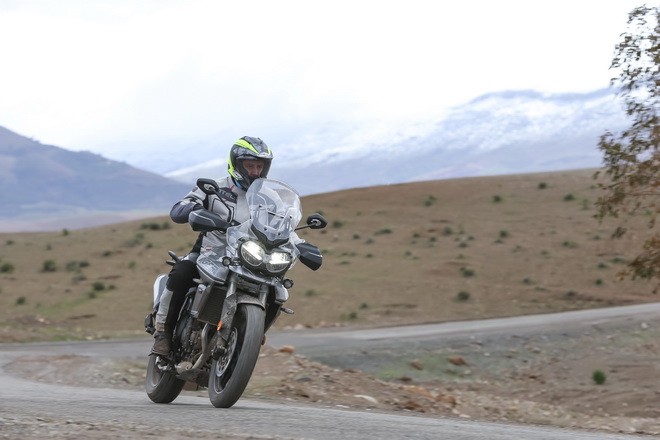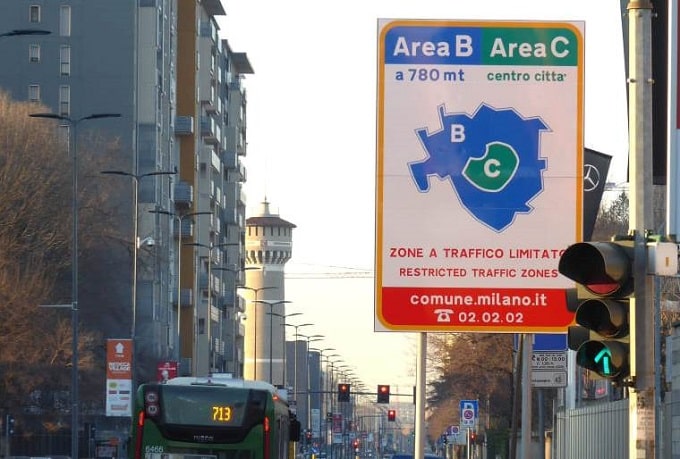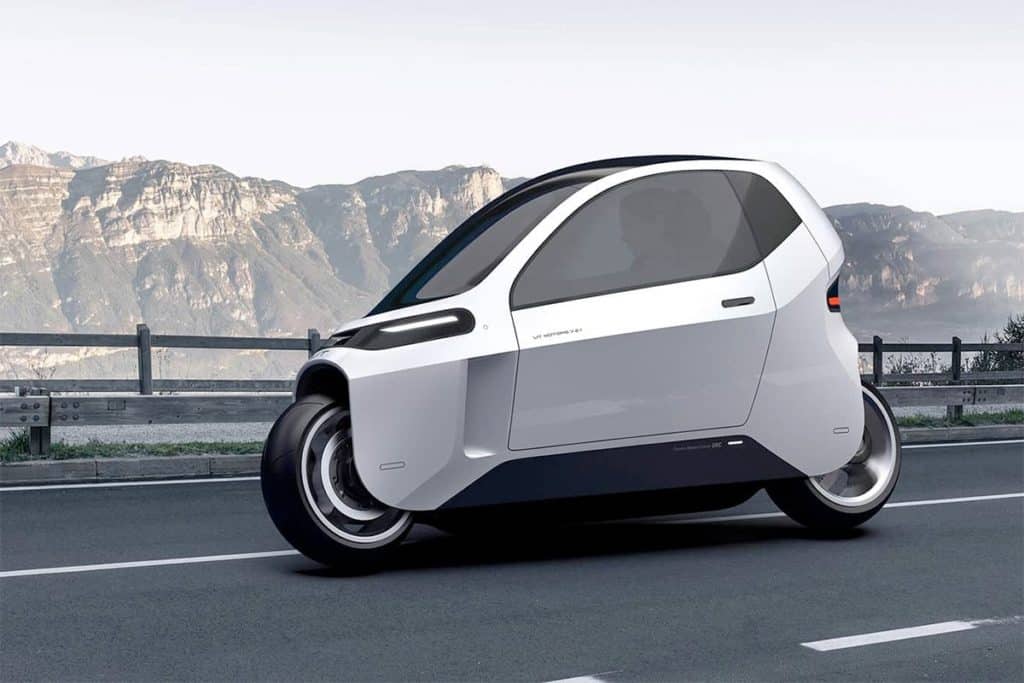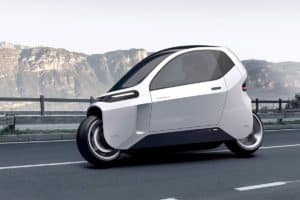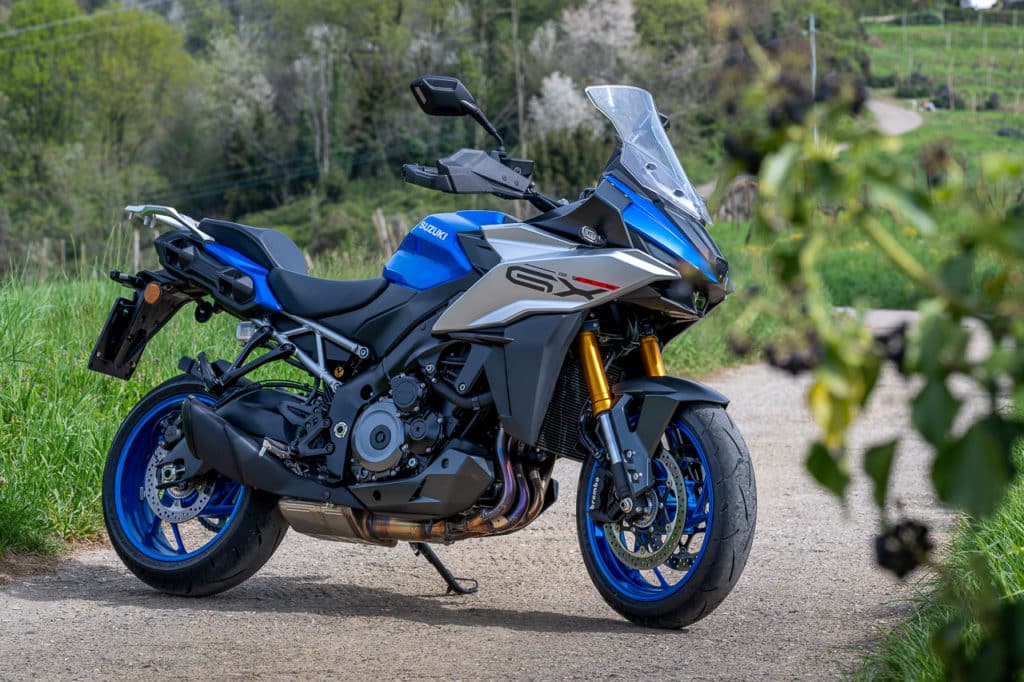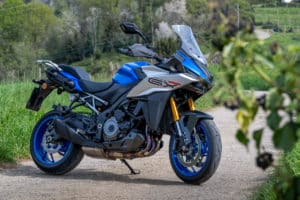Triumph Tiger 800 XC and XR 2018, versatile and increasingly different [ROAD TEST VIDEO]
Quality and technology increase for both
At the Eicma show, among the many Triumph innovations they were the queens of the stand. The new Tigers, 1.200 and 800, have introduced many big innovations. We went to Morocco to try the smallest 800, discovering how the best seller of the English company, with 68 thousand examples produced since 2010, has changed.
Younger sister? No thank you
Let's start by saying that the Tiger 800 is not only the smallest of the family, but it is also the most technical and most off-road of the Tigers. It is no coincidence that our test starts from Marrakech, to thoroughly test its characteristics. In addition to this, the two souls of the same motorbike have always been underlined by the two versions, XC and XR. Unlike other brands (it couldn't be otherwise, for an English company), XR is the name not of the version with spoked rims and wheel 21" front, but the one that focuses on driving on asphalt. With this generation, Triumph widens the gap, making one more suitable and ready for off-roading, the other sharper between the curves of the roads where you can push it to the limit. For both there are over 200 updates, including aesthetics, chassis, engine and more. Now it is a more modern, technologically advanced product, but also an easier motorbike capable of making riding more satisfying, on and off road.
A name with over 80 years of history
It is one of the longest stories in the world of two wheels. The name Tiger made its first appearance over 80 years ago in fact, with its ancestor who won the International Six Day Trial (ISDT) of 1936. Since then the name Tiger has become known by all motorcyclists and appreciated by the many who have had the opportunity to ride one in its various generations. Even though there are many changes, the latest arrival keeps the style unchanged, but places it ahead of the competition from many points of view. We had already seen it when we looked at it at Eicma and we had confirmation of it during the test. The desire to raise the bar is evident from at least two points of view: an increased attention to detail, as can be clearly seen by observing the couplings, the quality of the materials, but also elements such as the control button for the heated grips, perfectly integrated and pleasant to operate. The second direction in which we have gone is linked to technology. Things make their debut that make us think of the world of 4 wheels, such as virtualized instrumentation and full-LED headlights, but in addition to this we also find up to six driving modes, a cruise control with improved ergonomics, as well as other interventions that refine the bike from a chassis and engine point of view. If we really wanted to nitpick it, we could say that ABS cornering could have been included, at least as an option, but it is certainly not standard in its category.
Obviously the engine was also at the center of the technicians' attention. Modified in the masses, with a lighter flywheel to make it more responsive, this choice is also supported by the changes concerning electronics and gear ratios (the first is shorter to facilitate even the most difficult off-road maneuvers and passages). New and lighter then the exhaust. As there are always 95 horsepower, but the character and delivery are more aggressive, with a motorbike more reactive to the inputs imparted with the gas. The gearbox has been the subject of further refinements, together with the clutch, so the gear couplings have been optimized and you can feel it immediately when you put your hand (or rather foot) on the gearbox: more precise couplings and silent, to the benefit of the driving experience. The driving modes, which can reach up to 6 in the case of the XCa, make it perfect for a novice or satisfying for the more experienced rider, both off-road and on asphalt.
It changes face, but it is also more comfortable and with easier controls
The look of the motorbike changes, the business card becomes the luminous signature of the headlight with LED daytime light, which depending on the version can also be a full-LED, with the same technology also for low beam and high beam. However, small adjustments concern almost the entire appearance of the bike, with new plexy (adjustable to 5 positions) and also interventions on the side panels and in other areas. Virtually only the fuel tank remains unchanged, even if it's not a revolution. The suspension geometry has been tweaked, while the handlebar moves back by 10 mm, changing the riding position. Always with a view to greater quality, all Tiger 800s, excluding the entry level version, move to a braking system of the Italian Brembo. The suspension partners are prestigious, especially for the two top of the range ones: the XRt chooses multi-adjustable Showa, the XCa WP always with registers to modify the calibrations. The rear suspension, however, is less easy to adjust, because it is necessary to remove the saddle, but it only takes a few more moments. The solution adopted for the windscreen is truly interesting, offering 5 positions to choose from, with a simple and quick movement of one hand, which can be done without problems even on the move. The double soul of the Tiger 800, whichever you choose, is then confirmed by the new padding for the saddle, testifying to the fact that the "Tigerina" can be perfect for fairly extreme off-road use, but also for comfortably tackling a long journey. The practical and simple mechanism through which you can choose between a high or low position allows you to move the height from the ground by as much as 20 mm. There are many new functions, especially the digital instrumentation, but not only that, managed without having to move your hands from the handlebars. Certainly we need to get a little familiar with it, but the joystick it is practical and is one of the best solutions in terms of ergonomics. Everything is enriched by one key backlighting on the handlebars, which makes life easier when there is no external light.
Technology makes the difference
We have already mentioned it, as on the Tiger 1200, elements that bring to mind the automotive field also make their debut on the 800. A technology at the top of the category that includes essential details, such as the latest generation ABS, but above all a sophisticated system ride-by-wire, which introduces a mode for the first time Off Road Pro, but there is no shortage of traction control, advanced cruise control, an instrumentation that goes from physical to virtual, based on the vast 5" full-colour TFT display. In this segment only one other opponent could put so much on the field, she comes from Germany and will debut soon...
There's no denying it, expectations for this test were high, both for the bike and for the context chosen by Triumph: Morocco. The season is not exactly the best, so much so that we had to deal with rain, snow and temperatures close to freezing. In these places, however, we were able to appreciate the improvements made on the Tiger 800. Let's start from the conclusions, which however are not really conclusions: certainly, having to base our judgment on such a severe route, the XC would emerge victorious over the more road-oriented XR, but we are sure that, with clean asphalt and the right curves, you too could have your say by reversing our verdict. One has in fact become more supported in its suspension, this increases its driving precision and makes it more reactive, on the other hand it becomes nervous when there is mud under the tires instead of asphalt, with the 19" front closing more often than the 21st of the XC. The latter also has greater suspension travel (220 millimeters at the front and 215 at the rear, compared to 180-170 on the XR) and a greater saddle height (+30 mm). The differences between XC and XR are greater than in the past and it's quite noticeable when switching between them during the test.
But let's take a step back and talk about what they have in common. Once you get on the bike it is immediately clear that the quality has increased. Many details make it clear that nothing has been left to chance. It's difficult to find a detail out of place. Once the key is turned in the ignition, the new virtual instrument panel comes to life, the display of which is adjustable. The screen automatically switches from day to night mode, is enriched with customizations as the bike's configuration level increases and also changes its appearance depending on the selected riding mode. With the few dedicated keys you can move between the menu functions quite easily. However, with common sense it was decided to make the choice possible only with the bike stopped. Up to three themes can be set, while the 6 riding modes (all are available only on the XCa) can also be set when the bike is moving, as long as it is done with the throttle closed. The cruise control now features a simpler control, which we confirm is quick and intuitive.
The weight is practically unchanged, between 199 and 208 kg dry depending on the version, while, on the engine front, the three-cylinder is still the same, but the refinement work has borne fruit. The on-off switch is totally absent, while the few vibrations are only noticeable on the handlebars, but above all its character has been improved. Readier and quicker to react to the accelerator, it picks up well from around 1.700 rpm and climbs quickly with an engaging acceleration. The delivery curve is very smooth and gradual, not a surprise after seeing the flat torque curve, but not a disadvantage either. The three-cylinder is round and regular, but not devoid of character and taste. The gearbox is notable, very precise and silent in gear changes, which digests very well even without using the clutch, testimony to the excellent work done on the couplings of its gears.
The Tiger 800 is a versatile and easy to handle motorbike, with a double soul, which becomes four if we go back to the differences between XC and XR. For both, the short first makes it easier to maneuver the bike when stationary or at low speed, but it is off road that this becomes a great advantage. We will find out on the second day, driving in the Moroccan desert.
One of the big advantages of the new Tiger 800 XC is that finally booklet the specifications have been entered to be able to assemble knobby tires, just like them Pirelli scorpion which we used for the off road test in the desert, indispensable in the final part of our test. Until a few hours before, the rain had made it difficult to move on the roads that had been the scene of the road test, so there was a lot of fear of a "complex" off-road session. Luckily, the sun allowed us to worry less about aspects related to the weather and more about the bike, which accompanied us on a journey that was nothing short of fantastic. The right bike in the right place, we might say. In this scenario there are two methods to choose from, the Off Road , Off Road Pro. The first excludes the ABS at the rear, limiting the intervention of the traction control, while the "Pro" essentially "turns everything off", leaving control in the hands of the more expert riders. In many cases the help of electronics is useful, in ours, on this type of route, it is better to turn off the traction control completely. We decide to opt for an intermediate solution, using the "standard" Off Road mode, but excluding traction control from the menu. The three-cylinder here is priceless, docile and regular in taking turns, it makes everything easier even for the less experienced, but it is possible enjoy his nice stretch causing it to rev up while the rear Pirelli Scorpion digs into the compact surface, making the bike pick up speed. The WP suspensions they absorb and digest everything without ever going into crisis, even though the weight of the bike is not exactly trivial. Compared to its bigger sister the 1200, however, it is certainly a less demanding compromise to manage in a context like this, where the 800 is practically perfect. Between treacherous stretches traveled in first gear (shorter than in the past and you can feel it) and stretches where you see motorway speeds rather than off-road ones, the Tiger 800 is always perfectly at ease, it seems to have been created precisely for this use. Jumping it over the dunes, or putting it sideways while keeping the throttle wide open, seems like child's play, or at least not for Dakar pilots.
If you decide to buy this Tiger, we feel obliged to give you some advice. Take it at least once to a context like this desert area of Morocco, it will be an unforgettable experience and you will be able to take advantage of the qualities of the Tiger 800, otherwise wasted on the home-office route. Or, at least, buy it dreaming of being able to do so one day.
Also available in weakened version for the owners driving license A2, the new Triumph Tiger 800 has been done in 6, you understood correctly, with 4 versions for the XR road racer, including the XRx Low Saddle (LRH) at 760-780 mm from the ground (50 less than the standard), the top of the range XRt from 14.550 euros and the entry level “Basic” XR from 11.200. The XC starts instead by 13.650 and breaks through rich “a” version quota 15 thousand euros, stopping just over 15.050. We are talking about an increase of around 6-700 euros depending on the version, 850 for the XCa. In this we could find one of the few defects of the "Tigerina", a price that can become demanding and a difficulty in finding one's way in such a rich range. Others are difficult to find, although we, but let's get into the merits of subjectivity, would have liked a shortcut command with which to exclude or restore traction control. Instead we find it hidden in one of the many menus, reachable only with the bike stopped. True, if available, the Off Road Pro mode can do the same even on the move, but simultaneously excluding the ABS. More generally, given the complexity that has been achieved, it would be useful to have a storable setting, so as to find it every time the motorbike is turned on, which for safety reasons returns to Road mode when the ignition is turned off. New colors (there are now 2 for the XR, 4 for the XRx and XCx, 3 for the top of the range XCa and XRt) and a list of over 50 accessories complete the picture. The choice of being able to configure the Tiger based on the choice of one of its many versions practically makes the bags the only real accessory that can be purchased on the top of the range, everything else turns towards customization rather than truly enriching the bike. Also available Expedition pack, which makes the bike ready to go on long journeys, almost like the Tiger Tramontana, a prototype created for the development of the new Tiger 800 and which Felipe Lopez drove in last year's edition of the Pan Africa Rally.
Clothing used in the test:
For our test we wore Mtech Geographic jacket, Mtech Storm pants, Mtech Wind H20 gloves, Stylmartin Impact RS boots, Suomy MX Tourer helmet e Scott Prospect Goggles for driving in the desert.
if you want to always be updated on our news
Follow us here

